
Ulmus 'Plinio' is a hybrid elm cultivar derived from a crossing of the Dutch cultivar 'Plantyn' with the Siberian Elm Ulmus pumila clone 'S.2'. 'Plinio' was raised by the Istituto per la Protezione delle Piante (IPP), in Florence and released for sale in 2003. 'Plinio' was introduced to the UK in 2004 by Hampshire & Isle of Wight Branch, Butterfly Conservation, as part of its assessment of DED-resistant cultivars as potential hosts of the endangered White-letter Hairstreak.

Ulmus 'Nanguen' is a complex fourth generation Dutch hybrid cultivar raised at the Dorschkamp Research Institute for Forestry & Landscape Planning, Wageningen. Lutèce was derived from the cross 'Plantyn' ×, an ancestry comprising four field elms, a wych elm, the curious Exeter Elm ('Exoniensis'), and a frost-resistant selection of the Himalayan elm.

Ulmus × hollandica 'Vegeta', sometimes known as the Huntingdon Elm, is an old English hybrid cultivar raised at Brampton, near Huntingdon, by nurserymen Wood & Ingram in 1746, allegedly from seed collected at nearby Hinchingbrooke Park. In Augustine Henry's day, in the later 19th century, the elms in Hinchingbrooke Park were U. nitens. Richens, noting that wych elm is rare in Huntingdonshire, normally flowering four to six weeks later than field elm, pointed out that unusually favourable circumstances would have had to coincide to produce such seed: "It is possible that, some time in the eighteenth century, the threefold requirements of synchronous flowering of the two species, a south-west wind", "and a mild spring permitting the ripening of the samaras, were met."

Ulmus 'New Horizon' is an American hybrid cultivar raised by the Wisconsin Alumni Research Foundation (WARF), from a crossing of the Japanese Elm clone W43-8 = 'Reseda' with Siberian Elm clone W426 grown from seed collected from a street tree at Yankton, South Dakota. Tested in the US National Elm Trial coordinated by Colorado State University, 'New Horizon' averaged a survival rate of 74% after 10 years.'New Horizon' was patented in the US in 1994, while in Europe, it is marketed as one of the 'Resista' elms protected under EU breeders' rights.

Ulmus lamellosa, commonly called the Hebei elm, is a small deciduous tree native to four Chinese provinces, Hebei, Henan, Nei Mongol, and Shanxi, to the west and south of Beijing.
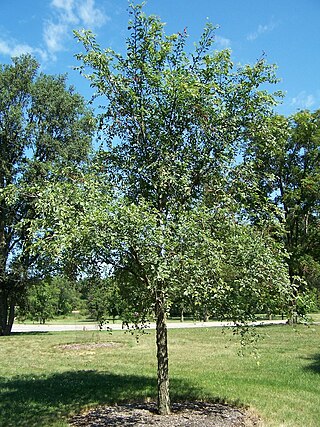
Ulmus chenmouiW. C. Cheng, commonly known as the Chenmou, or Langya Mountain elm, is a small deciduous tree from the more temperate provinces of Anhui and Jiangsu in eastern China, where it is found at elevations below 200 m on the Langya Shan and Baohua Shan mountains. The tree was unknown in the West until 1979, when seeds were sent from Beijing to the De Dorschkamp research institute at Wageningen in the Netherlands.

The Field Elm cultivar Ulmus minor 'Sarniensis', known variously as Guernsey Elm, Jersey Elm, Wheatley Elm, or Southampton Elm, was first described by MacCulloch in 1815 from trees on Guernsey, and was planted in the Royal Horticultural Society's gardens in the 1820s. It was listed in the Loddiges catalogue of 1836 as Ulmus sarniensis and by Loudon in Hortus lignosus londinensis (1838) as U. campestris var. sarniensis. The origin of the tree remains obscure; Richens believed it "a mutant of a French population of Field elm", noting that "elms of similar leaf-form occur in Cotentin and in northern Brittany. They vary much in habit but some have a tendency to pyramidal growth. Whether the distinctive habit first developed on the mainland or in Guernsey is uncertain."
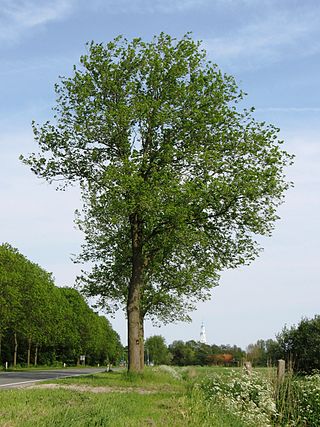
Ulmus × hollandica 'Commelin' is a Dutch hybrid cultivar released for sale in 1960. The tree was raised at Baarn as clone 274 by the Foundation Willie Commelin Scholten Phytopathological Laboratory in 1940, from a crossing of Ulmus × hollandica 'Vegeta' and clone 1, an Ulmus minor selected from a 1929 elm seedlings lot obtained from the Barbier nursery, Orléans.

The Dutch hybrid elm cultivar Ulmus × hollandica 'Groeneveld' was cloned in 1949 at the De Dorschkamp Institute, Wageningen, and released in 1963 in response to the earlier, less virulent form of Dutch elm disease that afflicted Europe shortly after the First World War. The cultivar was derived from a crossing of Dutch clones '49', and '1', a Field Elm Ulmus minor found in central France and marketed by the Barbier nursery in Orléans.

Ulmus 'Homestead' is an American hybrid elm cultivar raised by Alden Townsend of the United States National Arboretum at the Nursery Crops Laboratory in Delaware, Ohio. The cultivar arose from a 1970 crossing of the Siberian Elm Ulmus pumila with the hybrid N 215, the latter grown from seed sent in 1960 to the University of Wisconsin-Madison elm breeding team by Hans Heybroek of the De Dorschkamp Research Institute in the Netherlands. Tested in the US National Elm Trial coordinated by Colorado State University, 'Homestead' averaged a survival rate of 85% after 10 years. 'Homestead' was released to commerce without patent restrictions in 1984.
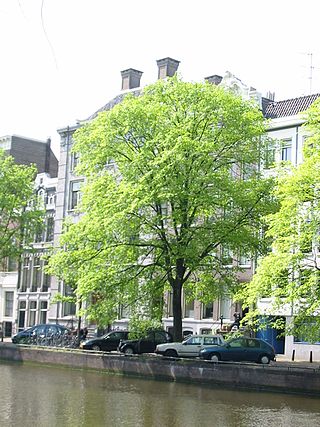
The hybrid elm cultivar Ulmus × hollandica 'Belgica', one of a number of hybrids arising from the crossing of Wych Elm with a variety of Field Elm, was reputedly raised in the nurseries of the Abbey of the Dunes, Veurne, in 1694. Popular throughout Belgium and the Netherlands in the 19th century both as an ornamental and as a shelter-belt tree, it was the 'Hollandse iep' in these countries, as distinct from the tree known as 'Dutch Elm' in Great Britain and Ireland since the 17th century: Ulmus × hollandica 'Major'. In Francophone Belgium it was known as orme gras de Malines.

Ulmus 'Columella' is a Dutch elm cultivar raised by the Dorschkamp Research Institute for Forestry & Landscape Planning, Wageningen. Originally thought to have been derived from a selfed or openly pollinated seedling of the hybrid clone 'Plantyn', DNA analysis later determined it arose from a cross of 'Plantyn' and Ulmus minor. Sown in 1967, it was released for sale in 1989 after proving extremely resistant to Dutch elm disease following injection with unnaturally high doses of the pathogen, Ophiostoma novo-ulmi. However, propagated by grafting onto wych elm rootstocks, graft failure owing to incompatibility has become a common occurrence in the Netherlands.

The Field Elm cultivar Ulmus minor 'Christine Buisman' was the first cultivar released by the Dutch elm breeding programme, initiated in response to the less virulent form of Dutch elm disease (DED), Ophiostoma ulmi, which afflicted Europe's elms after the First World War. 'Christine Buisman' was selected from a batch of 390 seedlings grown from seed collected in the Parque de la Quinta de la Fuente del Berro, Madrid, by Mrs Van Eeghen, a friend of elm researcher Johanna Westerdijk, in 1929 and named for the elm disease researcher Christine Buisman. Originally identified as Ulmus foliacea, it was later treated as Ulmus × hollandica by Melville. However, more recent research in Belgium using DNA markers has reaffirmed 'Christine Buisman' as a clone of U. minor.

The elm cultivar Ulmus minor 'Bea Schwarz' was cloned at Wageningen in the Netherlands, by the elm disease committee, from a selection of Ulmus minor found in France in 1939. However, specimens of the tree grown in the UK and the United States are falsely treated as Ulmus × hollandica.

The hybrid elm cultivar Ulmus 'Den Haag' is a Dutch development derived from a chance crossing of the Siberian Elm cultivar Ulmus pumila 'Pinnato-ramosa' and the Belgian Elm Ulmus × hollandica 'Belgica'. S. G. A. Doorenbos (1891-1980), Director of Public Parks in The Hague, finding that seeds he had sown in 1936 from the Zuiderpark 'Pinnato-ramosa' had hybridized with the local 'Belgica', selected six for trials. The best was cloned and grafted on 'Belgica' rootstock as 'Den Haag'; it was planted first in that city, then released to nurseries elsewhere in the Netherlands. The other five were also planted in The Hague.

The dwarf wych elm cultivar Ulmus glabra 'Nana', a very slow growing shrub that with time forms a small tree, is of unknown origin. It was listed in the Simon-Louis 1869 catalogue as Ulmus montana nana. Henry (1913), referring his readers to an account of the Kew specimen in the journal Woods and Forests, 1884, suggested that it may have originated from a witch's broom. It is usually classified as a form of Ulmus glabra and is known widely as the 'Dwarf Wych Elm'. However, the ancestry of 'Nana' has been disputed in more recent years, Melville considering the specimen once grown at Kew to have been a cultivar of Ulmus × hollandica.
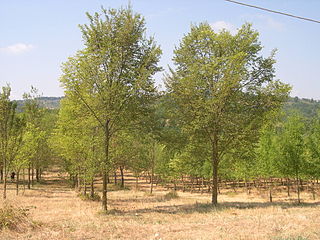
Ulmus 'Arno' is an Italian hybrid cultivar derived from a crossing of 'Plantyn' with the Siberian Elm Ulmus pumila clone S.2. It was raised by the Istituto per la Protezione delle Piante (IPP) in Florence, and released in 2007. However, 'Arno' was not a commercial success; propagation had ceased by 2010, and it is no longer patent protected.

Ulmus 'Fiorente' is a hybrid cultivar elm derived from a crossing of the Siberian Elm Ulmus pumila clone 'S.10' from Lucca, Italy, with the Ulmus minor clone 'C.02' from Lungarno, Florence, by the Istituto per la Protezione delle Piante (IPP), part of the Italian National Research Council, in Florence. The tree is protected by Plant Breeders' Rights bestowed by the EU on 25 March 2010.
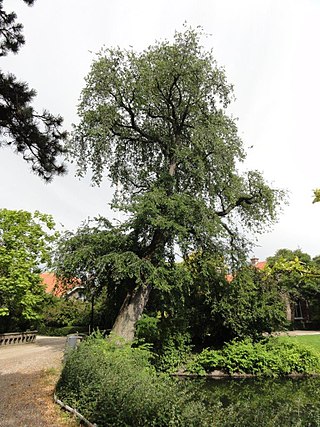
The Field Elm cultivar Ulmus minor 'Pendula' was said to have been raised in Belgium in 1863. It was listed as Ulmus sativa pendula by C. de Vos in 1887, and by Boom in 1959 as a cultivar.

The Chinese Elm cultivar Ulmus parvifolia 'Hokkaido' is an older cultivar of Japanese origin.






















